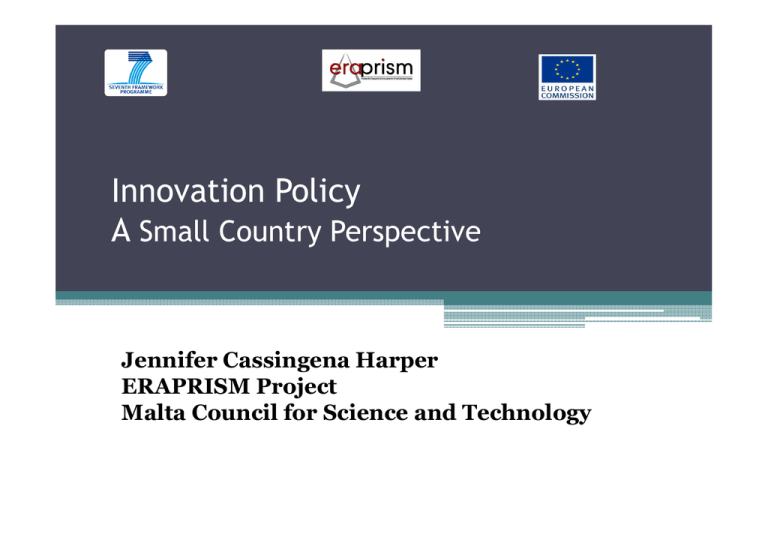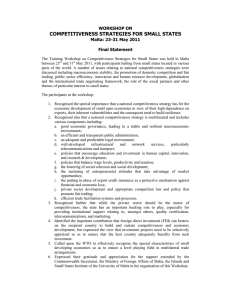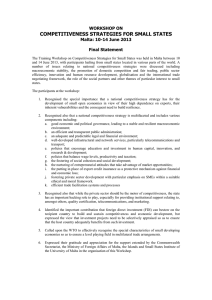Innovation Policy A Small Country Perspective Malta-Commonwealth Workshop on
advertisement

Malta-Commonwealth Workshop on Competitive Strategies for Small States Innovation Policy A Small Country Perspective Jennifer Cassingena Harper ERAPRISM Project Malta Council for Science and Technology Outline • • • • • • Definition Rationale Ongoing and Emerging Trends Insights from ERAPRISM Project Benchmarking for Competitiveness Current Trends in Malta’s Innovation Policy • Information Sources/ Links • Questions for discussion Definition Innovation Policy – “the integral of all state initiatives regarding science, education, research, technology policy and industrial modernisation, overlapping also with industrial, environmental, labour and social policies… (It) aims to strengthen the competitiveness of an economy .. in order to increase societal welfare through economic success” (S. Kuhlmann – Research Policy 2001 Vol.30) Innovation policy aims to remedy deficits in firms or the environment in which they operate with the aim of increasing the rate and success of new and improved products, processes and services (L. Georghiou, PREST, University of Manchester) Competitiveness is….. • Firms’ ability to produce better or cheaper products, processes and services and hence to defend or gain market share; • A country’s ability to provide the conditions which enable firms to achieve this; Ref: Metcalfe & Georghiou (1991) • the set of institutions, policies and regulations that support high levels of productivity…..and drive productivity growth and sustained increases in output!! Ref: Global Competitiveness Report (2004) Ongoing Trends in Innovation Policy • Linkage of Innovation Policy to Grand Societal Challenges • Policy watching and evaluation is a prime activity of policymakers and increasingly a range of stakeholders in the innovation game • Growing convergence of policy approaches as states monitor each others’ policies, for copying and more positively for policy learning. This process is helped along by the use of such policy tools as benchmarking and open method of coordination within EU context. • Foresight approaches to align research and innovation to longterm policy needs and for joined-up policy approaches across government. • Increasing involvement of stakeholders in policy formulation and implementation through foresight In small states, foresight approaches are particularly effective in addressing resource constraints and lack of critical mass. Recent trends in Europe Farhorizon Foresight on European Innovation Policy • Innovation has moved to the centre-stage of policy attention • Facing the double challenge of ▫ Enhancing the attractiveness of Europe as a destination for investments in innovation ▫ Dealing with Grand Challenges in the ERA • The deficits of current innovation policy are increasingly recognised ▫ Need for overhauling rationales ▫ Need for better policies ▫ Need for new forms of governance EU FP7 Farhorizon Project presentation by Matthias Weber Rationales for innovation policy • Governments typically intervene in the national innovation ecosystem when there are market or system failures in the innovation process. • Market failures generally arise through firms being unable to capture all of the benefits of their investments in innovation or to deal with uncertainty. ▫ In small economies, most knowledge used will originate outside the country but to exploit these knowledge spillovers will require: a domestic investment in R&D a highly connected R&I ecosystem Rationales for innovation policy System failures occur due to ▫ inadequacies in the physical or knowledge infrastructures and in the ability of innovation actors to coordinate effectively. ▫ firms being unaware of new technologies outside their normal sphere of activity and risk being displaced by disruptive innovations. . Rationales for Innovation Policy System failure in small countries • This poses a particular threat to small countries, as firms may be less well placed to monitor developments and loss of a firm may not be balanced by emergence of new players. Government needs to step in to identify and address gaps in support provided. • It may not be economic for the private sector to provide innovation support mechanisms such as technological, business or export advice in a small and intermittent market for specialised consultancy. Importing such advice may be impractical because of lack of knowledge of local conditions. Government may need to step in to remedy the deficiency. Forms of Government Intervention Government measures (at national, regional and local level) to address problems or failures in the ecosystem: ▫ Framework conditions including laws, social rules, routines, habits, technical standards which influence the environment within which firms are operating; ▫ Networking and interactions between firms and other players in different sectors and/or countries and regions (including research performers, intermediaries, standard-setting organizations, NGOs) ▫ Lock-in to obsolete technologies or business models; ▫ Supply-side and Demand-side measures Towards Open innovation New broader-based view of innovation highlights: • critical importance of research and innovation ecology: the network of relationships between innovation actors and environment which structures those relationships. • open innovation - ability to source knowledge developed elsewhere or to be a knowledge supplier has started to transform business models and processes. • This development has led to an embedding of local knowledge production activities in global innovation networks, whilst recognizing that users can play a prominent role in innovation activities -‘user-driven-innovation’ Source: Farhorizon Innovation workshop 2010 Greater concern with … • User needs and interests reflected in growing recognition of importance of innovation in services, accounting for 70% of GDP in most European countries - services have been neglected targets of innovation for a long time, but difficulties in measurement. • Social and organisational innovations as not only complementary to technological innovation, but as equally important dimensions of change in their own right. There is no single innovation model that fits the requirements of all fields of innovation. • sectoral and thematic specificities of innovation. due to greater diversity in research and innovation patterns European innovation policy • Reappraisal of European innovation policy underway • Changes in societal demands on innovation and changes in R&I practices lead to realisation that efforts to underpin the technological base, though vital, were insufficient in terms of providing the environment in which innovative firms would flourish and grow. • Economic crisis and other pressing challenges have reinforced the urgency to act. • Demand-side policies (market friendly to innovation) • Societal challenges require mobilising R&I resources in parallel with measures to stimulate demand ▫ public support/appreciation of these investments ▫ action required goes beyond domain of research policy EU 2020 Flagship: Innovation Union • Focus on innovations addressing the major societal challenges- a broad concept of innovation involving all actors and regions in the innovation cycle including SMEs • key guiding principle: “From idea to market” emphasising a coordinated approach addressing deficiencies/bottlenecks from knowledge production, through investment in innovation to providing the right demand and regulatory environment to support success. • Areas of action: a renewed effort to achieve the ERA objectives (e.g researcher mobility and infrastructures) and recognition of nontechnological factors, e.g. design and social innovation. • use of Cohesion Funds for R&I and “smart specialisation” and a series of other efforts to improve availability of finance including a legal framework for transnational VC funds and revisions to the State Aid framework. • Demand-side: Single Innovation Market and achieving an EU Patent, revised regulatory, a review of the EU standardisation system and the use of procurement for innovation. • Innovation Partnerships ERAPRISM Mission Helping small European countries, through more effective R&I policy design, to play their role in the drive to establish the European Research Area Premises • There is an advantage in helping small countries understand better their R&I challenges • Small European countries benefit from links with larger member states Population size <2.5M Iceland 0.3M Malta 0.41M Luxembourg 0.48M Cyprus 0.78M Estonia 1.34M Slovenia 2.03 M Latvia 2.27M Our Concerns: National Context Framework conditions Policy lock-in Critical mass Brain drain FDI dependency Smart specialisation Adequacy of indicators Project Partners Malta: MCST UK: UNIMAN Estonia: HM Iceland: RANNIS Slovenia: SRA Latvia: LTC Sweden: VINNOVA UK: BIS France: UPEMLV OST Luxembourg: CHT and FNR Advisory Group: Austria: BMWF Cyprus: Planning Bureau Germany: Steinbeis Ireland: FORFAS Concerns for small countries • All stages from idea to market will rarely be contained in a small economy –need for internationalisation emphasised even more strongly. • Non-R&D based innovation is important for small countries- due to reliance on service sectors (e.g tourism) and strengths in sectors such as software where innovation can come from new configurations and applications of existing technologies. Few have extensive means to identify/ promote innovations of this nature. • Mobility of researchers is a desirable but limited facilities and critical mass require they maintain a balanced two-way flow of researchers and avoid brain-drain. Concerns for small countries • Specialisation is both a necessity and a risk for small countries as it increases vulnerability to sectoral downturns or shifts in competitive advantage to other locations. • Harmonised policies may be beneficial to the EU as a whole but may not meet the specific needs of small countries – e.g. inappropriate benchmarks • Additional governance requirements of the new initiative may be burdensome for small countries Innovation Challenges for Small countries • Human resources and specifically the need to increase the supply of science and engineering graduates. exacerbated in some cases by an imbalance in the inward and outward flows of qualified people. • Unsufficient level of business R&D and innovative activities • Specific needs of SMEs and micro-enterprises given the industrial structure of the countries concerned. • Need to improve productivity for better innovative performance. • Need for public-private and research-business links. • Specialisation in sectoral niches appropriate to economy – e.g. sectors where competitive advantage is easier to defend. • Social innovation, non-technological innovation, Creative industries The EU2020 Innovation Union Political context • Communication adopted by the Commission on October 6th 2010. • Council Conclusions adopted at the Competitiveness Council meeting of November 26th 2010. • European Council of February 4th also adopted conclusions on innovation. Main action lines • • • • • Strengthening Europe’s knowledge base. Getting good ideas to the market. Maximising regional and social benefits. Pooling efforts for breakthroughs – European Innovation Partnerships. Collaborating internationally. The linkages between the objectives of the Innovation Union and the new R&I Strategic Plan are clearly evident. The New R&I Strategic Plan 2011-2020 - strategic thrusts • Identify and build on the constants and success factors – guiding principles, R&I Programme, capacity-building. • Identify and address the bottlenecks, barriers and gaps – in particular need for dedicated innovation policy. • Mission, vision and strategic principles still valid and will be retained, thus retaining flexibility in the detail and consistency in the overall vision. • Priority setting, efficient and effective use of resources will be key common threads in the 2011-2020 strategic plan. • European and international context and developments will form part of the background landscape for this new R&I strategic plan. • Measures and actions will be tailored within the inherent constrains brought about by Malta’s small size and openness of its economy. • Need to balance ambition in the vision-setting with realistic action plans and requests for resources. The New R&I Strategic Plan 2011-2020 - principles An ecosystem approach to R&I • Supporting innovation in its widest sense. • Ensuring linkages and continuity of support from one stage to the next. • Ensuring the right framework conditions are in place. Smart specialisation • Identifying and investing in specific niches. Grand Challenges • Building critical mass, excellence and research competitiveness. • Alignment with and capitalisation on European approach of using research investments to address societal challenges. • Balancing advantages and risks of this approach. • Strive towards an analogous model supporting the alignment of national challenges to national research and innovation efforts. Information Sources/ Links ERAPRISM – www.eraprism.eu FARHORIZON – http://farhorizon.portals.mbs.ac.uk/ActivitiesandOutputs/Activities/tabid/1645/language/ en-US/Default.aspx World Economic Forum – Global Competitiveness Index http://www.gcr.weforum.org/ EU http://www.proinnoeurope.eu/index.cfm?fuseaction=page.display&topicID=5&parentID=51 Trendchart http://trendchart.cordis.europa.eu/tc_policy_measures_overview.cfm http://europa.eu.int/comm/research/era/3pct/pdf/report-directmeasures.pdf Erawatch http://www.erawatch-network.eu OECD http://www.oecd.org/home/0,2605,en_2649_34273_1_1_1_1_1,00.html Malta http://www.mcst.org.mt / http://www.mbs.ac.uk/research/innovation Horizon scanning and foresight EU http://cordis.europa.eu/foresight/actors_eur.htm http://cordis.europa.eu/foresight/regional_blueprints2004.htm http://ec.europa.eu/research/agriculture/scar/index_en.cfm?p=3_foresight http://www.foresight-platform.eu/ http://forera.jrc.es/documents/eur20128en.pdf http://forlearn.jrc.es/guide/0_home/index.htm http://www.eranet-forsociety.net/ForSociety/files/document/Deliverables/D17New_Foresight_Training_Schemes.pdf http://www.futurreg.net/toolkit.html European Science Foundation http://www.esf.org/activities/forward-looks.html OECD www.oecd.org/department/0,3355,en_2649_33707_1_1_1_1_1,00.html UNESCO http://portal.unesco.org/shs/en/ev.phpURL_ID=1520&URL_DO=DO_TOPIC&U RL_SECTION=201.html UNIDO Manual http://www.unido.org/doc/45321 Institute for Alternative Futures http://www.altfutures.com/ UK http://www.doingforesight.org/doingForesight.php, www.sigmascan.org, www.deltascan.org, http://prest.mbs.ac.uk/prest/SCOPE/index.htm Malta: http://www.cs.um.edu.mt/~gpac1/Teaching/Foresight Bibliography • Innovation Policies in Europe and the US: The New Agenda Biegelbauer and Borras (Ashgate, 2003) • Creating an Innovative Europe: Report of the Independent Expert Group on R&D and Innovation appointed following the Hampton Court Summit: January 2006 • The Green Paper on the European Research Area (2007) http://ec.europa.eu/research/era/consultation-era_en.html • Creative System Disruption towards a research strategy beyond Lisbon: Synthesis report: Key technologies expert group: 4th September 2005 • Communication from the Commission: Building the ERA of knowledge for growth: Commission of the European Communities • Sustaining Innovation-Driven Growth – 2010 Plan: Ministry of Trade and Industry Singapore: 2006 • The ten-year Science & Innovation Investment Framework Annual Report 2005: HM Treasury; DTI HM Revenue & Customs: July 2005 • Lambert Review of Business-University Collaboration: Final Report: 2003 • Defining Innovation: a consultation on the definition of R&D for tax purposes: HM Treasury; DTI HM Revenue & Customs: July 2003 • Competing in the global economy: the innovation challenge: DTI: December 2003 For discussion • The degree to which small countries require either different innovation policy instruments or different mixes of these instruments. • Whether the moves towards open innovation and towards broader concepts of innovation have particular significance for smaller countries? • The significance of the Innovation Union policies for small countries; and • Recent changes in small countries innovation policies, including those resulting from responses to the economic crisis.




